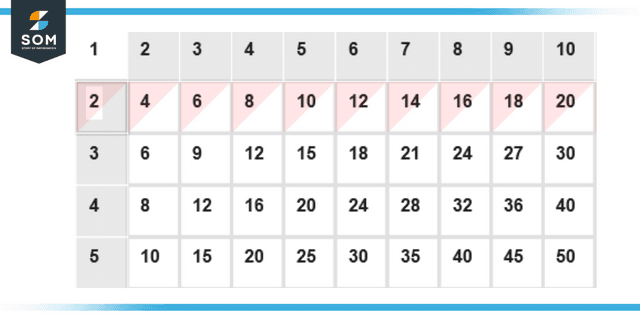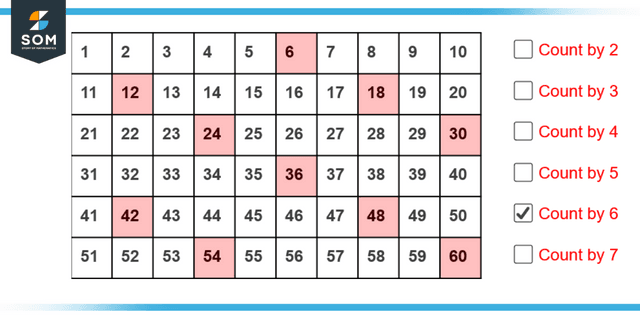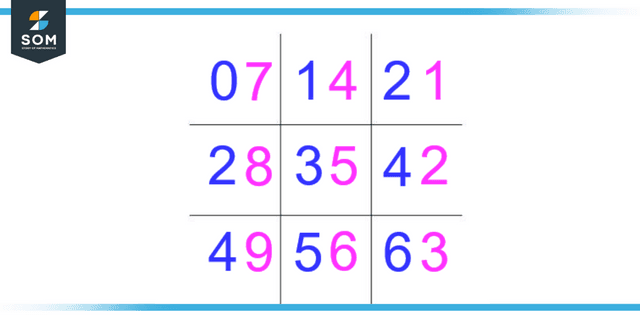JUMP TO TOPIC
Times Tables|Definition & Meaning
Definition
A times table is a type of mathematical table utilized to define an algebraic system’s arithmetic operations.
What Are Times Tables?
A list of the number’s multiples is known as a multiplication table. The multiplication table can be obtained by multiplying the supplied number by whole numbers in the appropriate order. The mathematical operation of multiplication is one of the fundamental operations introduced to pupils at a young age. A multiplication table chart is a helpful tool for providing pupils with a straightforward introduction to the concept of multiplication.
Knowing your times’ tables can be a precious tool when completing calculations in elementary mathematics. These are the foundation for more advanced mathematical operations such as fractions, exponents, and many more.

Figure 1: 2-5 times table
What Is a Chart of the Multiplications?
A table that displays the result of multiplying two integers is called a multiplication chart. In most cases, one set of numerical values is recorded in the left column, and another set of numerical values is recorded in the top row. Using a multiplication chart helps save a significant amount of time and effort when performing mathematical computations.
Multiplications Chart With the Times From 1 to 10
The 1 to 10 section includes the numbers printed in order from 1 to 10 on the row and column that are furthest to the left of the grid. Each box in the remaining rows and columns represents a number as the combination of two numbers; one number comes from the row to the far left, and the other comes from the row to the far right.
Tables of Multiplication From One to Twenty
Learning multiplication tables is essential for performing calculations involving several digits and finding solutions to problems involving fractions, percentages, and factoring. A child who has mastered these times tables between 1 to 20 is better able to perform mental arithmetic and handle more complex computations.
How To Keep the Multiplication Tables in Memory
Students often need help learning their multiplication tables by heart. Students having trouble memorizing these times tables can benefit from the helpful hints we have provided.
- Putting “skip-counting” into practice
- Recite the table of multiplications in the correct sequence.
- Exercise your writing skills.
- Put your multiplication skills to use in the real world.
- Identify patterns
Practice Skip Counting
It would be helpful if you initiated with a number and added more. For example, if you start with 4, continue adding 4 after each iteration of the count. So you would say 4, 8, 12, 16.

Figure 2: Illustration of skip counting by 6.
Read off the Times Table in Order
Beginning with “10 times 1 is 10,” moving on to “2 times 10 is 20,” “3 times 10 is 30,” and so on.
Exercises in Reverse Table Recitation
Include learning to recite the multiplication table in reverse order. Beginning at the bottom of the column is where you should begin. For example, you could begin by saying, “3 times 30 is 90,” “2 times 20 is 40,” and so on. If you are having trouble learning the multiplication table through memorization, you always have the choice of writing it out and studying it that way.
Practice by Writing It Out
Make it a habit to write down the multiplication tables and then go through the motions of reciting them once daily.
Apply the Concept of Multiplication To Real Life
Make an effort to comprehend multiplication tables by applying examples from real life. You might also attempt to exercise your multiplication skills in various situations. For instance, multiplying the price of one product by the total number of goods or multiplying the amount by the total number of notes in a bundle would result in the same price.
Find the Patterns
Each multiplication table has its pattern, and you need to find it. The recognition of this pattern is of the utmost significance. It will make it easier for you to commit these multiplication tables to memory.

Figure 3: Times table of 7.
The Importance of the Times Tables
Even if even an elementary calculator could be used to perform these multiplications, using such calculators is strongly discouraged for two reasons.
The first is that using calculators is typically frowned upon at the elementary and middle school levels of education. Second, using these tools prevents students from improving their mental arithmetic skills, which can be of great use in daily life situations.
It is crucial to envision the multiplication tables in mathematics and memorize them until the learner can remember any particular multiple, such as “seven of eights are.” This will make it easier for the student to memorize the tables and speed up the learning process.
One other technique to commit the tables to memory is writing them out numerous times as practice. The student can master all three methods for learning the tables concurrently if they recite them while simultaneously visualizing them and writing them down.
When children go from early to secondary education, their ability to do arithmetic operations quickly and accurately becomes a vital skill. It is vital to recall multiples up to 20 to do calculations such as finding the least common multiple or determining the end velocity of an item travelling at a specific acceleration.
In addition, if you need to multiply huge numbers, you have no choice but to rely on basic multiplication techniques after you move past the table of 20.
As an illustration, the first thing that must be done to multiply 36 and 18 is multiplying 6 and 8. For the learner to proceed past the first step, they need to remember that forty-eight is equal to six eights. Knowing the multiplication tables in math can be quite helpful in situations like this.
Some Examples of Time Tables
Example 1
Write out the first 5 elements of the 10 times table.
Solution
10 * 1 = 10
10 * 2 = 20
10 * 3 = 30
10 * 4 = 40
10 * 5 = 50
Example 2
Write the first 5 elements of the 35 times table.
Solution
35 * 1 = 35
35 * 2 = 70
35 * 3 = 105
35 * 4 = 140
35 * 5 = 175
All images/graphs are created by using GeoGebra.
